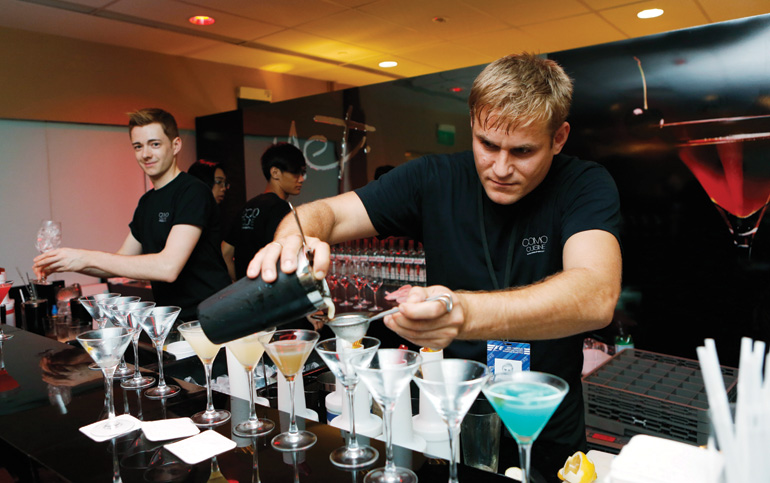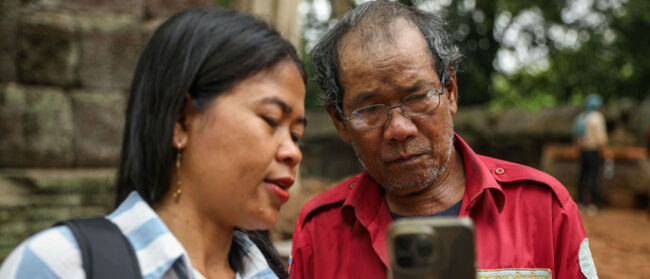
Barrelling along a Singapore overpass in a bright orange Lamborghini Spyder, I look up at overhanging rain trees and, for a moment, the thrill of driving a car very, very fast is comprehensible.
I’ve never exactly been the fast-moving type. From a childhood placing last in every running race to friends assigning the tortoise as my ‘spirit animal’ as an adult, travelling at pace has never been a high priority.
So going behind the scenes at the Singapore GP – where the world’s most skilled drivers face off in the fastest road vehicles technology can produce – was, therefore, an intriguing prospect. First pit stop? Getting a feel for what drivers experience on the track.
Pushing the limits
Shabaz, the driver employed by Ultimate Drive, a Singapore company that allows the curious and the car-crazy to test out top-of-the-range sports cars, is 23 but looks even younger. His right elbow pokes out of the Lamborghini’s window while he casually turns the steering wheel with his left hand.
After 15 minutes of alternately whizzing around the city centre and puttering along in traffic, I ask Shabaz how fast he had just gone. “When you’re concentrating on driving, you don’t really look at the speed; you’ve got to keep your eyes on the road,” he says, eventually admitting that it was probably up to 160km/h. The speed limit in Singapore is 90km/h.
Such speeds might feel quick, but they are a fraction of those reached by the likes of Lewis Hamilton and Sebastian Vettel when these calm, ordered streets are transformed into a petrolhead’s dream for a few days each year.
As one of the longest in Formula One, Singapore’s Marina Bay street circuit presents unique challenges for the drivers, who must navigate the winding 5.065km track and its 23 turns at speeds of up to 300km/h. Drivers often do not manage to complete the 61 laps within the designated two-hour time limit, in place for driver safety reasons, because of the technical difficulty of the track.
“Drivers sweat off three to four kilograms in our race, so it really is a good weight loss drug – just drive two hours and lose four kilograms”
Eiktha Khemlani, Singapore GP
Held at night since its inception in 2008, in part to match European television scheduling, but also to bring down temperatures for drivers, the heat in the cockpit can still reach up to 60°C.
“Drivers sweat off three to four kilograms in our race, so it really is a good weight loss drug – just drive two hours and lose four kilograms,” quips Eiktha Khemlani, assistant communications director at Singapore GP, which holds the Formula One rights to stage the event. “You really need to be physically fit to do this race. You do in other circuits as well, but because of the humidity and heat, you sweat a lot in our race.”
Given the sheer amount of pressure drivers are under, spectacular crashes are common, and every single Singapore Formula One race has seen a safety car deployed at some point. But while the thrills and spills are what attract many of the 87,000 daily spectators to the three-day event, which includes a number of smaller support races, for others it’s the action trackside that draws them in.
“The track was designed, really, to be in the heart of the city where not only do you get a very good street race but you’re in an area where you can see the sights of interest around Singapore,” says Christopher Choo, assistant technical director at the GP.
Circuit breakers
But the prime bayside location of the circuit – which runs alongside the Singapore Flyer, past the durian-shaped opera house and is a stone’s throw from some of the city’s top hotels – also presents some major challenges for those working to ensure the event goes off without a hitch. For a start, it took a little convincing to get business owners in the area onside – many of whom would be affected by several days of road closures.
“The first year, it was a bit of a surprise for a lot of people, including ourselves, because there was no rule book for how to do a Formula One,” says operations director Sarah Martin. “It was a case whereby we were creating an event and executing an event simultaneously. But we were very lucky, because we had such huge government support, and with the government backing and with the backing of private stakeholders who also saw the benefit of the race it made the first year a lot easier.”
With the power of official approval and the business community’s acquiescence, the Singapore GP is now an integral part of the city-state’s annual calendar, not to mention a tourist magnet. About 40% of attendees are foreign visitors, and the event adds an estimated $110m to the economy each year through tourist spending. And it tends to go off without a hitch – although last year, a 27-year-old British man wandered onto the track in a rare incident that sparked major concern from race teams.
Martin, who also oversees security, says the errant pedestrian was quickly dealt with in a response by the police force and the army. “We are a street race, and a street race is unlike a fixed circuit, it works on a highly different mode of operation,” she says. “It is, I think, far more challenging than the norm.”
To meet that challenge is a veritable army of 1,500 security personnel and 1,000 ushers, all under her command. “It’s a fairly massive operation,” she says. “The key challenge is logistics, because you have so many different types of concerns, and we have a very complex site terrain. We have multiple modes of security, so what we do is: deployment is based on areas of concern.”
Fast food
But what visitors to the track will likely notice first is the staggering array of food and beverage options: there are about 60 bars and restaurants strategically located throughout the circuit park, offering everything from traditional hawker fare to Korean, Thai and Japanese cuisine.
“What we try to do is to showcase what’s in Singapore. So you get your Hard Rock Cafés, your Harry’s Bar, you also get your Dancing Crab – a lovely little restaurant in Singapore. You get what Singapore has to offer, inside the circuit park,” Martin says. “The food culture is so important to us, so we curate the bars and restaurants, and they all have different looks and feels. And it changes every single year.”

Feeding the legions of VIPs, who can pay thousands for a three-day event pass and therefore expect five-star food and service, is another matter altogether. There are about 4,000 such attendees at the Paddock Club – exclusive suites above the pits that give ticketholders a view over the finish line and a pre-race option to walk down the pit lane past the teams’ garages, plus a further 6,000 at the corporate hospitality suites.
Sunil Shamdasani, director of food and beverage operations, says meeting the high expectations of these guests, as “the palate of the clientele in Singapore has become very refined”, is far from easy. Each year brings impetus to top the delights of the last as food trends evolve, and chefs are usually flown in from around the world to demonstrate their culinary talents, while cutting-edge food is served to diners.
“A lot of people see the front of house, but they don’t see [what goes on in] the back,” Shamdasani says. It is a large-scale yet intricate operation, refined over the years, that involves six high-end hotels coming together to cater a menu designed by Shamdasani’s team.
“We’re in the heart of the city, as a city race, and we’re blessed with hotels that are in reach,” Shamdasani says. “We work very closely with the executive chefs of the hotels and their sous chefs.
“The majority of items are finished off to 70% level in the hotel kitchens. Then, they are transported onto the site. There are many issues, of course, such as safety and hygiene: how do you achieve the fanciness and the quirkiness of what you want to do – you want to push the boundaries, but how do you ensure a safe environment? That’s paramount.”
A class act
Entertainment is also key, with up to nine stages that in past years have hosted the likes of Rihanna, Justin Bieber, Maroon 5, Jennifer Lopez, Tom Jones and Shakira. Smaller, more low-key acts, from jazz trios to roving drumming troupes, can also be found throughout the circuit park.
“We have a mix of things – stuff that’s on the stage, stuff that’s off the stage – the whole point is to match the action that’s on the track. And all of this goes [on] in between the races,” Martin says.
Timing is crucial, as there are small windows of 30 minutes or one hour separating each race. “It’s down to the minute, just like the race is down to the last second or minute, we make sure the race is finished and the next minute, the stage starts,” Martin says. “We’ve been blessed. Every single one of our artists – and some of them are notorious for not getting on stage on time – has always gone onto the stage on time.”
Yet the devil is truly in the details, and Singapore GP staffers spend the entire year fine-tuning every element of the course, from the 1,600 lights that illuminate the circuit to the surfaces of the roads, which deteriorate with use each year.
“The other considerations we have are, for example, is there enough open space to place grandstands? That’s one reason why we are in this corner [of the city] rather than the central business district where you have a lot of skyscrapers. In terms of the track design itself, you need to make sure that the circuit is about 5km long,” Choo says.
“The lights go in first because we build from the outside of the track inwards,” he adds. “So you have the lights, then, in front, the track barriers come into place. This work starts around the end of April, early May, and we’re done some time in the middle of October to late October, when all the infrastructure is taken out.”
Formula One brings to mind images of victorious drivers drenching one another in champagne, business deals clinched over fine whiskey and elegant cocktail-fuelled parties. But behind the hype, the glitz and the glamour is a thousands-strong team that comes together each year to bring the Singapore GP to fruition. Before the drivers arrive in their grid positions revving their engines, until after the chequered flag is waved, the legions of workers are always there, amid the loud hum of the vehicles, quietly running a well-oiled machine.


